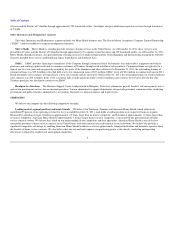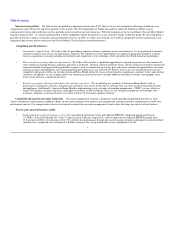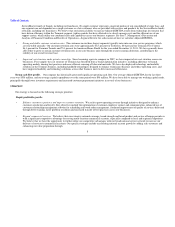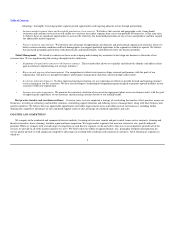American Home Shield 2011 Annual Report Download - page 18
Download and view the complete annual report
Please find page 18 of the 2011 American Home Shield annual report below. You can navigate through the pages in the report by either clicking on the pages listed below, or by using the keyword search tool below to find specific information within the annual report.
Table of Contents
Availability of our raw materials and increases in raw material prices, fuel prices and other operating costs could adversely impact our business, financial
position, results of operations and cash flows.
Our financial performance is affected by the level of our operating expenses, such as fuel, fertilizer, chemicals, raw materials, wages and salaries,
employee benefits, health care, vehicle, self-insurance costs and other insurance premiums as well as various regulatory compliance costs, all of which may be
subject to inflationary pressures. In particular, our financial performance is adversely affected by increases in these operating costs. In recent years, fuel prices
have fluctuated widely, and previous increases in fuel prices increased our costs of operating vehicles and equipment. We cannot predict what effect the recent
global events could have on fuel prices, but it is possible that such events could lead to reduced fuel supplies, resulting in higher fuel prices. With respect to
fuel, our fleet, which consumes approximately 21 million gallons annually, has been negatively impacted by significant increases in fuel prices in the past and
could be negatively impacted in the future. Although we hedge a significant portion of our fuel costs, we do not hedge all of those costs. A ten percent change
in fuel prices would result in a change of approximately $6.5 million in the Company's annual fuel cost before considering the impact of fuel swap contracts.
Based upon current Department of Energy fuel price forecasts, as well as the hedges the Company has executed to date for 2012, the Company has projected
that fuel prices will increase our fuel costs by $10 million to $15 million for 2012 compared to 2011. Fuel price increases can also result in increases in the
cost of fertilizer, chemicals and other materials used in our business. We cannot predict the extent to which we may experience future increases in costs of
fuel, fertilizer, chemicals, raw materials, wages, employee benefits, healthcare, vehicles, insurance and other operating costs. To the extent such costs
increase, we may be prevented, in whole or in part, from passing these cost increases through to our existing and prospective customers, and the rates we pay
to our subcontractors and suppliers may increase, any of which could have a material adverse impact on our business, financial position, results of operations
and cash flows.
We may not successfully implement our business strategies, including achieving our growth objectives.
We may not be able to fully implement our business strategies or realize, in whole or in part within the time frames anticipated, the anticipated benefits
of our various growth initiatives. Our various business strategies and initiatives, including our productivity and customer retention initiatives, are subject to
significant business, economic and competitive uncertainties and contingencies, many of which are beyond our control. In addition, we may incur certain
costs to achieve efficiency improvements in our business. Even if these efficiency improvement initiatives are undertaken, we may not fully achieve our
expected cost savings and efficiency improvements or these initiatives could adversely impact our customer retention and/or our operations. In addition, our
strategies to enhance talent management and transfer best practices across our businesses may not produce the efficiencies and productivity levels we seek and
may present unforeseen challenges. Also, our business strategy may change from time to time. As a result, we may not be able to achieve our expected results
of operations and cash flows.
Our market segments are highly competitive. Competition could reduce our share of the market segments served by us and adversely impact our
reputation, business, financial position, results of operations and cash flows.
We operate in highly competitive market segments. Changes in the source and intensity of competition in the market segments served by us impact the
demand for our services and may also result in additional pricing pressures. The relatively low capital cost of entry to certain of our business categories has
led to strong competitive market segments, including competition from
16
























